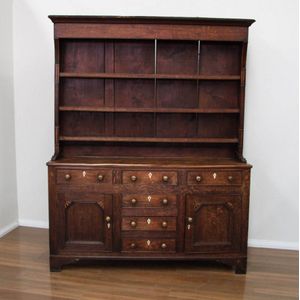Early 20th Century French Oak Armoire with Carved Top
You must be a subscriber, and be logged in to view price and dealer details.
Subscribe Now to view actual auction price for this item
When you subscribe, you have the option of setting the currency in which to display prices to $Au, $US, $NZ or Stg.
- Bevel / Chamfer - In furniture making, a chamfered corner refers to a technique used to create a smooth, angled edge on the corner of a piece of furniture. This is typically done by cutting away a small portion of the corner at an angle, typically 45 degrees, creating a diagonal edge, rather than a sharp 90-degree angle. This technique can be used on various parts of a piece of furniture such as table legs, drawer fronts, or door frames. Chamfering can add visual interest to a piece and can help to soften the overall look of a piece of furniture. It is often used in conjunction with other techniques, such as rounding edges or using contrasting wood species to create a more elegant, sophisticated look. Chamfering is a simple way to add a touch of elegance to a piece of furniture and it is a common technique used by furniture makers.
- Oak - Native to Europe and England, oak has been used for joinery, furniture and building since the beginning of the medieval civilisation. It is a pale yellow in colour when freshly cut and darkens with age to a mid brown colour.
Oak as a furniture timber was superceded by walnut in the 17th century, and in the 18th century by mahogany,
Semi-fossilised bog oak is black in colour, and is found in peat bogs where the trees have fallen and been preserved from decay by the bog. It is used for jewellery and small carved trinkets.
Pollard oak is taken from an oak that has been regularly pollarded, that is the upper branches have been removed at the top of the trunk, result that new branches would appear, and over time the top would become ball-like. . When harvested and sawn, the timber displays a continuous surface of knotty circles. The timber was scarce and expensive and was used in more expensive pieces of furniture in the Regency and Victorian periods. - Breakfront - A design generally found in larger pieces of furniture, such as bookcases, wardrobes and some sideboards. The line of the front is interrupted by the middle section standing out from each end. In a reverse breakfront, the centre section is recessed behind each end. Breakfronted pieces are usually made in three sections the middle and the two wings which are held together by the cornice and pediment, and the plinth on which it stands. The sensible buyer should show caution before buying breakfront pieces, especially bookcases, which are highly desirable and expensive. Always check that the timber, colour, patination, backboards, decoration and thickness of the wood are same in each section.
This item has been included into following indexes:
Visually similar items

A pair of vintage silver cufflinks, comprising double rectangular discs with tapering edges, chain fittings. Engraved pattern to the centre of the links with scroll detail to the ends. Hallmarked: Chester and dated 1936.

A Victorian heart shaped porcelain scent bottle painted with a scene of a courting couple, sterling silver screw cap, English circa 1900, 5.5 cm long

A George III 18th century oak Welsh dresser, the raised back with pediment and frieze, above three moulded shelves, the base with three frieze drawers, above three further drawers, flanked by panel door cupboards. 200 cm high, 162 cm wide, 45 cm deep.

A Rene Lalique Esterel vase, designed 1923, the baluster body moulded with overlapping leaves, in frosted amber and clear glass, moulded R. Lalique, 15.5 cm high. Provenance: Decorative Arts and Furniture, Silver and Jewellery, Christie's Australia, Melbou
